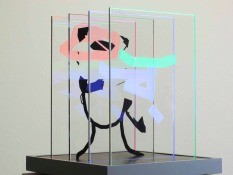
The sculptures appear in the color change, which makes the viewers stunned.
Nowotny is actually a painter. His work incorporates the visual aesthetics of the media world into medieval portraits. Through the use of abstract means, he successfully transformed the symbolic existence of portraits into a formal and ornamental structure. Holding the idea of ​​adding a third dimension to the pattern, he decided to make several paintings into glass sculptures. Nowotny explains: “I break down the elements in the painting into planes and then convert those planes into layered glass. When viewed from the front, the layers of glass are integrated into the original look.†Presenting unique brightness, this breakthrough innovation concept is almost an inevitable trend, and this is the best thing for OSRAM Opto Semiconductors MultiLED: they can be accurately placed in specific locations, and the color and intensity are adjustable of.
The glass sculpture shown above consists of four glass plates with a thickness of 8 mm and a longitudinal arrangement of approximately 385 mm2 and a total height of 430 mm. The patterns on the three glass plates are made by laser engraving, while the other one is black. When viewed from an appropriate distance, the shape of the sculpture will appear. MultiLED illuminates the pattern to create a sense of three-dimensionality. Twelve red, green and blue LEDs are arranged on the metal core circuit board to illuminate three laser-engraved glass plates from below. Inside the glass plate, light is conducted through total internal reflection. They refract at the engraving point to penetrate the glass and the pattern in the glass glows. Through the ingenious programming of various LED colors, different color themes and color changes can be realized, and the viewers will continue to present a novel and interesting visual feast.
For Peter Nowotny, his work of art can complement LED light, opening up a whole new level of artistic expression. He said: "The use of LED technology has become an important part of my artistic creation." In addition to illuminating the laser engraving in glass sculpture, he also added a led light source to several sculptures with sticky color films. In these works, the color of the film and the color of the LED light merge to each other, which brings out a unique visual appeal.
Sand Casting is made of clay-bonded sand as a molding material. It is a process method with a long history. It is also the most widely used process method. In the development of various chemical bonding sand, the clay wet sand is still the most important molding material, and its application range is wide and the consumption is large, and it is not comparable to any other molding material. It is reported that in the steel castings of the United States, more than 80% of the clay-wet molding sand is used; in Japanese steel castings, more than 73% of the clay-wet molding sand is used.
Sand Casting,Sand Casting Tube,Sand Casting Process,Inron Sand Casting Pats
Dongguan Formal Precision Metal Parts Co,. Ltd , https://www.formalmetal.com